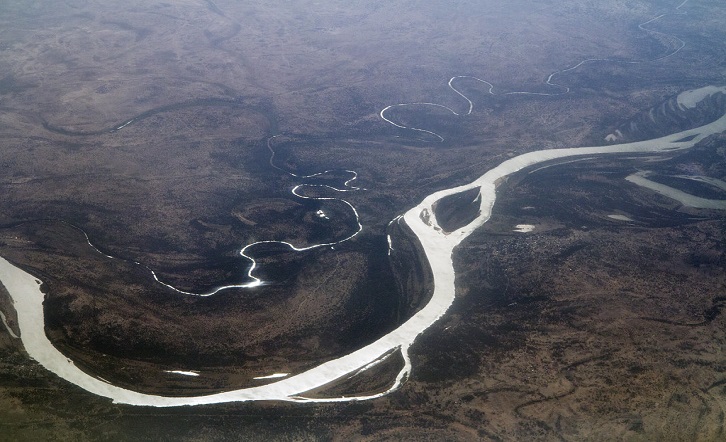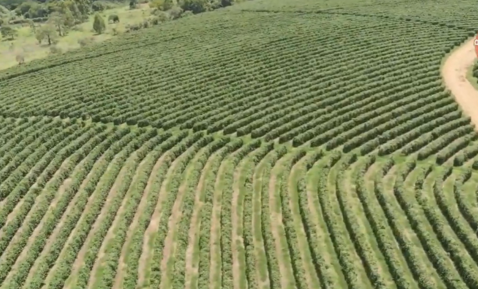Ancient Terraces in the Chad Basins: Unlocking the Secrets of a Lost Civilization
The Ancient Terraces in the Chad Basins are a marvel of engineering and ingenuity, but how were they formed? These structures, believed to have been built by an ancient civilization, have fascinated scientists and archaeologists for centuries. Through careful examination of the terraces and the surrounding landscape, researchers have uncovered the secrets behind their formation.
The terraces were formed through a combination of natural processes and human intervention. The Chad Basins, located in the present-day countries of Chad, Niger, and Nigeria, are characterized by a flat and arid landscape. The terraces were created by manipulating the existing topography to create a series of stepped platforms.
Ancient inhabitants of the region used a variety of techniques to shape the land. They would dig channels and divert water from nearby rivers and streams to irrigate the terraces. By carefully controlling the flow of water, they were able to create an efficient agricultural system that allowed them to cultivate crops in an otherwise inhospitable environment.
The construction of the terraces required a deep understanding of hydrology and engineering. The builders had to carefully calculate the gradient of each terrace to ensure proper water flow and prevent erosion. They also had to consider the stability of the structures, using techniques such as retaining walls and terracing to prevent collapse.
The formation of the Ancient Terraces is a testament to the resourcefulness and ingenuity of the ancient civilization that built them. It is a reminder that even in the most challenging environments, human beings have always found ways to adapt and thrive.
Geological significance of the Ancient Terraces
The geological significance of the Ancient Terraces in the Chad Basins cannot be understated. These structures provide valuable insights into the geological history of the region and the forces that have shaped it over thousands of years.
The terraces are primarily composed of sedimentary rocks, such as sandstone and limestone, which are abundant in the Chad Basins. These rocks were deposited millions of years ago when the area was covered by ancient lakes and rivers. The layers of sediment are clearly visible in the terraces, allowing geologists to study the geological history of the region.
By analyzing the composition and characteristics of the rocks, geologists can determine the age of the terraces and the processes that formed them. This information can help reconstruct past climatic conditions and understand the geological forces that have shaped the landscape.
The terraces also provide evidence of tectonic activity in the region. The Chad Basins are located in a seismically active area, and the terraces show signs of uplift and deformation. By studying these features, geologists can gain insights into the tectonic processes that have shaped the landscape over time.
The geological significance of the Ancient Terraces goes beyond their scientific value. They also serve as a reminder of the dynamic nature of our planet and the powerful forces that have shaped it. They are a testament to the resilience of the ancient civilization that built them and their ability to adapt to a changing environment.
Archaeological discoveries on the Ancient Terraces
Archaeological excavations on the Ancient Terraces in the Chad Basins have yielded remarkable discoveries that shed light on the lives of the ancient civilization that built them. From intricate artifacts to ancient pottery, these excavations have provided valuable insights into the culture and way of life of the people who once inhabited the region.
One of the most significant archaeological discoveries on the terraces is the presence of ancient agricultural tools. Excavations have uncovered stone hoes, sickles, and grinding stones, indicating that the terraces were used for farming purposes. This provides further evidence that the terraces were an advanced agricultural system designed to support a large population.
Archaeologists have also found evidence of settlements on the terraces. The remains of ancient houses and other structures have been unearthed, revealing the architectural techniques used by the ancient civilization. The buildings were constructed using locally available materials, such as mud bricks and thatch, and were designed to withstand the harsh climate of the region.
In addition to these structural remains, archaeologists have discovered a wealth of artifacts, including pottery, jewelry, and tools. These artifacts provide insights into the daily lives of the ancient inhabitants and their cultural practices. They also reveal the extent of trade networks and cultural exchange in the region.
The archaeological discoveries on the Ancient Terraces highlight the rich cultural heritage of the Chad Basins and the importance of preserving these sites for future generations. They provide a window into the past and offer valuable clues about the history and civilization of the region.
Cultural and historical importance of the Ancient Terraces
For centuries, the terraces have been an integral part of the cultural landscape of the Chad Basins. They are often associated with myths, legends, and oral histories that have been passed down through generations. They are considered sacred by many local communities and are the sites of religious ceremonies and rituals.
The terraces also have significant historical value. They provide insights into the ancient agricultural practices and technological advancements of the region. They are a tangible link to the past, connecting present-day communities to their ancestors and their shared history.
The cultural and historical importance of the Ancient Terraces has gained recognition at the national and international levels. Efforts have been made to preserve and protect these sites, ensuring that they remain accessible to future generations. UNESCO has recognized the terraces as World Heritage Sites, acknowledging their universal value and the need for their preservation.
The preservation of the Ancient Terraces is not only important for cultural and historical reasons but also for economic development. The terraces attract tourists from around the world, generating revenue for local communities and contributing to the overall economy of the region.
The role of climate change in the formation of the Ancient Terraces
Climate change has played a significant role in the formation of the Ancient Terraces in the Chad Basins. The terraces are a response to the challenges posed by the region’s arid and unpredictable climate, and they represent an innovative solution to adapt to changing environmental conditions.
The Chad Basins experience a highly variable climate, with periods of prolonged drought followed by intense rainfall. This variability poses significant challenges for agricultural productivity and water management. The terraces were built as a means to regulate water flow and ensure the availability of water for irrigation during dry periods.
By diverting water from rivers and streams, the ancient civilization that built the terraces created a system that allowed for the efficient use of water resources. The terraces acted as reservoirs, storing water during periods of heavy rainfall and releasing it slowly during dry spells. This not only ensured a steady water supply for agriculture but also minimized the risk of flooding and soil erosion.
The terraces also served as a means to mitigate the effects of climate change on soil fertility. The layers of sediment deposited on the terraces acted as natural fertilizers, replenishing the nutrients in the soil. This enabled the ancient civilization to sustain agricultural productivity in an otherwise challenging environment.
The role of climate change in the formation of the Ancient Terraces highlights the adaptive capacity of human beings. It demonstrates our ability to innovate and find solutions to the challenges posed by a changing climate. The terraces serve as a reminder that sustainable agricultural practices and water management techniques are essential for building resilience in the face of climate change.
Unique flora and fauna found on the Ancient Terraces
The terraces support a rich ecosystem of plant life. The availability of water and nutrients in the soil allows for the growth of a diverse range of crops, including millet, sorghum, and vegetables. These crops not only provide sustenance for local communities but also contribute to the biodiversity of the region.
In addition to agricultural crops, the terraces are also home to a variety of wild plant species. These include native grasses, shrubs, and trees, which have adapted to the arid conditions of the Chad Basins. Many of these plant species have medicinal properties and are used by local communities for traditional healing practices.
The terraces also provide habitat for a range of animal species. The availability of water and vegetation attracts a variety of bird species, including waterfowl and migratory birds. The terraces also support populations of small mammals, reptiles, and amphibians, which play important roles in the ecosystem.
The unique flora and fauna found on the Ancient Terraces highlight the ecological value of these structures. They provide habitat for a variety of species and contribute to the overall biodiversity of the Chad Basins. It is important to preserve and protect these ecosystems to ensure the survival of these species and maintain the ecological balance of the region.
Impact of the Ancient Terraces on local communities and tourism
For local communities, the terraces are a source of cultural pride and identity. They are a tangible link to their ancestors and their shared history. The terraces are often associated with local myths and legends, and they play an important role in religious and cultural practices. They are a source of inspiration and a symbol of resilience and ingenuity.
The terraces also have a direct impact on the livelihoods of local communities. The agricultural practices associated with the terraces provide sustenance and income for many families. The terraces support the cultivation of a variety of crops, which are essential for food security and economic stability.
Tourism is another significant economic benefit associated with the Ancient Terraces. The terraces attract visitors from around the world who are fascinated by their historical and architectural significance. Tourism provides employment opportunities for local communities, including tour guides, hospitality staff, and artisans. It also generates revenue for the local economy, supporting small businesses and community development initiatives.
However, the impact of tourism on the Ancient Terraces must be carefully managed to ensure their long-term sustainability. Sustainable tourism practices, such as visitor management and environmental conservation, are essential to minimize negative impacts on the terraces and their surrounding ecosystems. Community involvement and benefit-sharing are also important to ensure that local communities derive tangible benefits from tourism.
Conclusion: Preserving the legacy of the Ancient Terraces
The Ancient Terraces in the Chad Basins are a testament to the ingenuity and resourcefulness of an ancient civilization that once thrived in the region. These remarkable structures, with their advanced engineering techniques and intricate architectural designs, offer a glimpse into a bygone era.
Through archaeological research and analysis, we have uncovered the significant scientific facts behind the Ancient Terraces. From their formation in response to climate change to their role in regulating water flow and supporting agriculture, each terrace holds a unique story waiting to be told.
The terraces have immense cultural, historical, and ecological value. They are a source of pride for local communities and a symbol of their cultural identity. They provide insights into the history and civilization of the region, connecting present-day communities to their ancestors.
Preserving the legacy of the Ancient Terraces requires a collaborative effort. Archaeologists, site managers, and local communities must work together to ensure their long-term sustainability. Conservation efforts, including research, site management, and community engagement, are crucial for protecting these sites and sharing their significance with the world.
The Ancient Terraces also have the potential to contribute to the economic development of the region through tourism. By attracting visitors from around the world, the terraces generate revenue for local communities and support small businesses. Sustainable tourism practices are essential to minimize negative impacts and ensure the long-term viability of the terraces as tourist destinations.
As we continue to unravel the mysteries of the Ancient Terraces in the Chad Basins, let us remember the importance of preserving and protecting these remarkable structures. They are a testament to human ingenuity and a window into our shared history. By safeguarding their legacy, we ensure that future generations can continue to be inspired by the remarkable achievements of the ancient civilization that built them.
Top of Form




